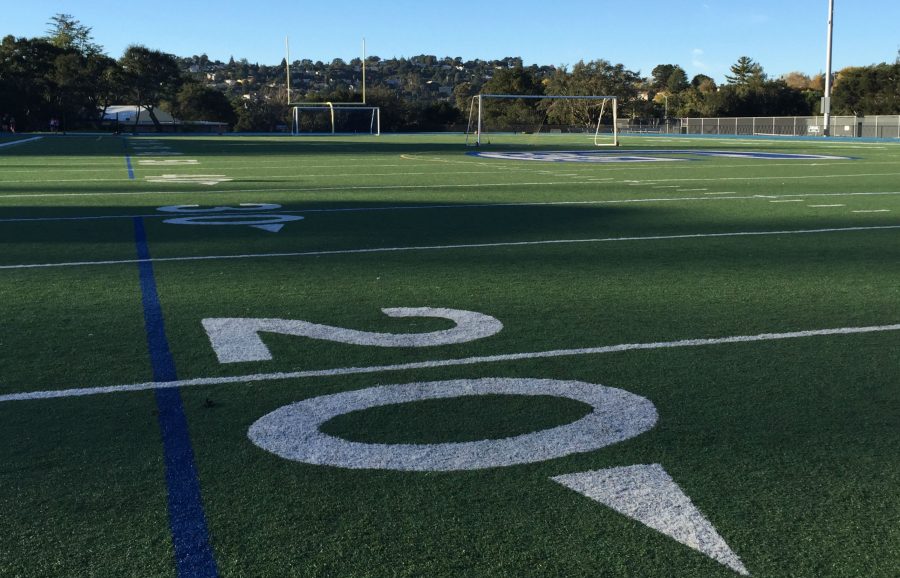Straight ahead, coming at you full speed, and bam.
A student opens their eyes to find themselves laying in the middle of the field looking up at the bright lights beaming down on them. Suddenly, they can’t remember what the score was, or the team they were playing against.
They just got a concussion.
1.6 million to 3.8 million concussions occur each year, according to the Centers for Disease Control.
Carlmont varsity football coach Jake Messina said, “There is an extreme amount of awareness and hysteria about [concussions] right now.”
A concussion is a brain trauma that is caused by a bump, blow, or jolt to the head or body and can disrupt the way the brain regularly functions.
Carlmont athletic trainer Ann Sbardellati said, “[A concussion is] any injury to the brain causing bruising which would create symptoms.”
In Sbardellati’s single year of being the athletic trainer for Carlmont, she has encountered 15 to 20 students with concussions. Sbardellati also estimates that 20 percent of team players are likely to receive a concussion, which can have a range of effects depending on the amount of contact a sport will have.
There are many different symptoms used to identify concussions. Many find that it’s not always easy to know if someone has a concussion. Passing out or losing consciousness are not the only symptoms.
According to the Brain Injury Association of Virginia, most concussions actually take place when there is no loss of consciousness.
“If the collision is extreme, and the player comes out and they’re rocking and don’t have balance, that’s one way you can tell they may have a concussion,” Messina said.
Along with a poor balance, symptoms such as headache, dizziness, nausea, sensitivity to light and noise, a foggy head, pressure in one’s head, dilated pupils, double or fuzzy vision, and confusion are also common.
For students, concussions can affect their GPA and school work, due to potential migraines, memory loss, and concentration issues.
According to Sbardellati, concussions decrease one’s reaction time and affect one’s concentration, anxiety, and sleep schedule.
Long term, concussions can have a substantial impact on one’s emotional health and can create personality changes.
The National Collegiate Athletic Association (NCAA) states emotional responses can include sadness, isolation, irritation, lack of motivation, anger, frustration, changes in appetite, and disengagement.
Recovery time for concussions varies depending on how bad the concussion is.
California state law states a seven-day rest is the minimum. If someone has a headache or dizziness due to what may be a concussion, they are out of the sport for seven days, regardless of a doctor’s statement.
After receiving a concussion, a player can reach out for additional medical assistance depending on how severe the concussion may be.
“First, you have to get diagnosed by a doctor, then you go through protocol with us [Carlmont athletic trainers], a doctor, or a physical therapist. If it’s severe, then you go to vestibular therapy, which is eye work and eye tracking. You can also go to a neurologist, clinics, and studies,” said Sbardellati.
The amount of awareness on concussions has grown greatly since previous years.
“In the past, doctors used to grade concussions. Sometimes they were mild, medium, or all the way up to high. Now they don’t do that, so you either have one or you don’t. When I played, I got knocked silly and I just wanted to play so badly that I just went back in and at that time there was no protocol,” said Messina.
Before the recent hysteria of concussions, they weren’t taken seriously unless there was a major physical problem.
Sbardellati said, “If someone didn’t see a physical sign, like if someone didn’t pass out or their eyes weren’t dilated, then they figured it was not serious.”
Concussions are now being taken more seriously than ever.
Carlmont athletes don’t have a choice to take concussions seriously or not, the second that signs and symptoms can be identified and medical personnel are involved, then players are out of the game.
“I think there is an extreme amount of awareness on concussions. Unfortunately, we’re not the toughest society and it’s feeding into an anti-physicality culture that we’re getting into,” Messina said.
All coaches and trainers at Carlmont have gone through a concussion training with Heads Up and the Center for Disease Control to keep student-athletes safe.
Although the only way to not receive a concussion during the sports season is to simply not play, there are some ways to help prevent concussions.
According to The Brain Injury Alliance of New Jersey, the best ways to prevent concussion are to play by the rules, wear the appropriate equipment for your sport properly, practice good sportsmanship, and learn and use proper technique for your sport.
“To absolutely avoid a concussion, just don’t play,” said Messina.












